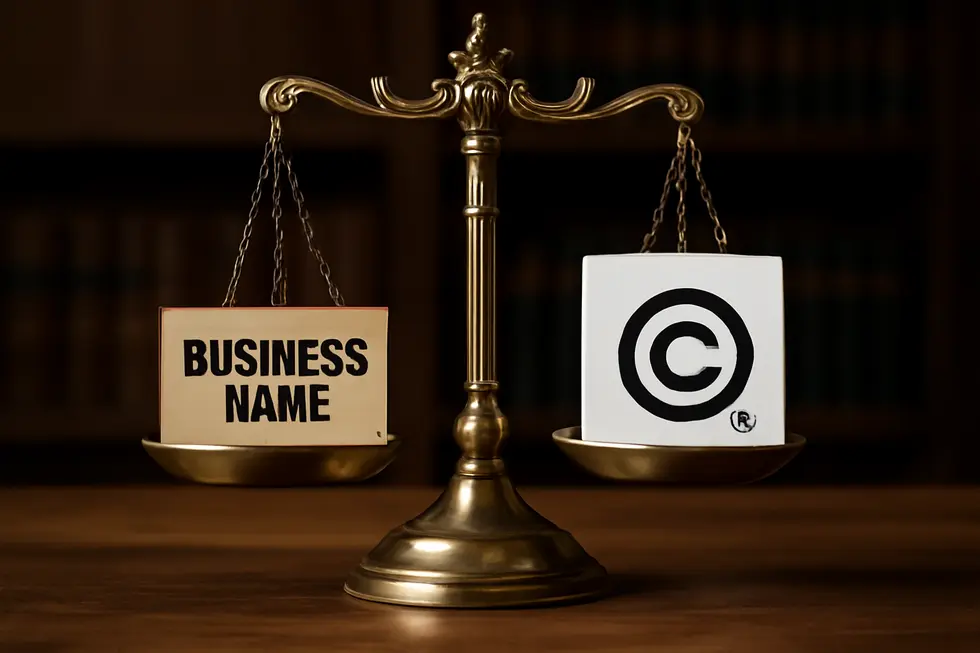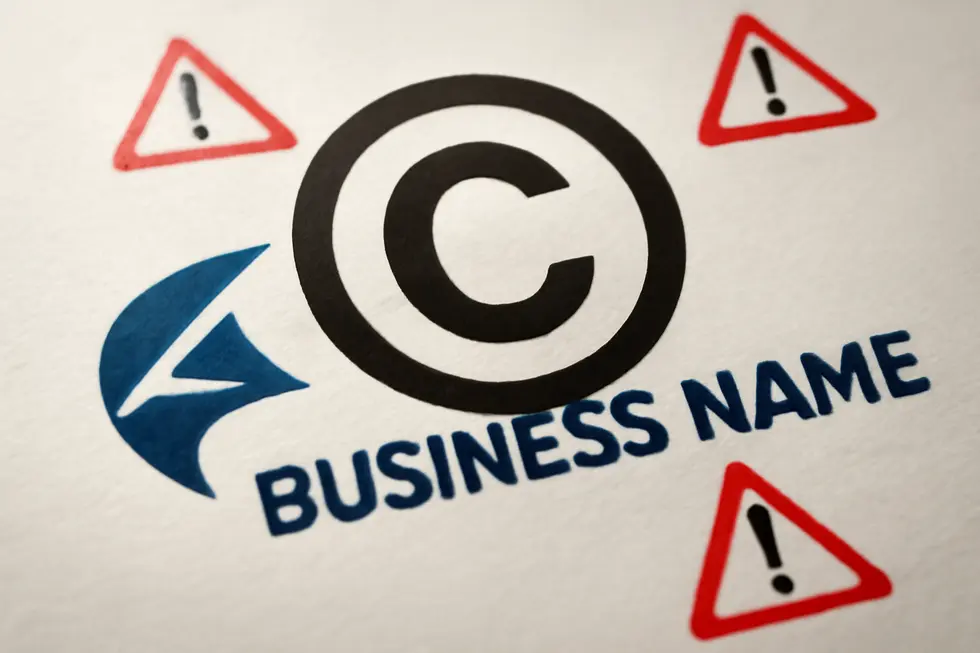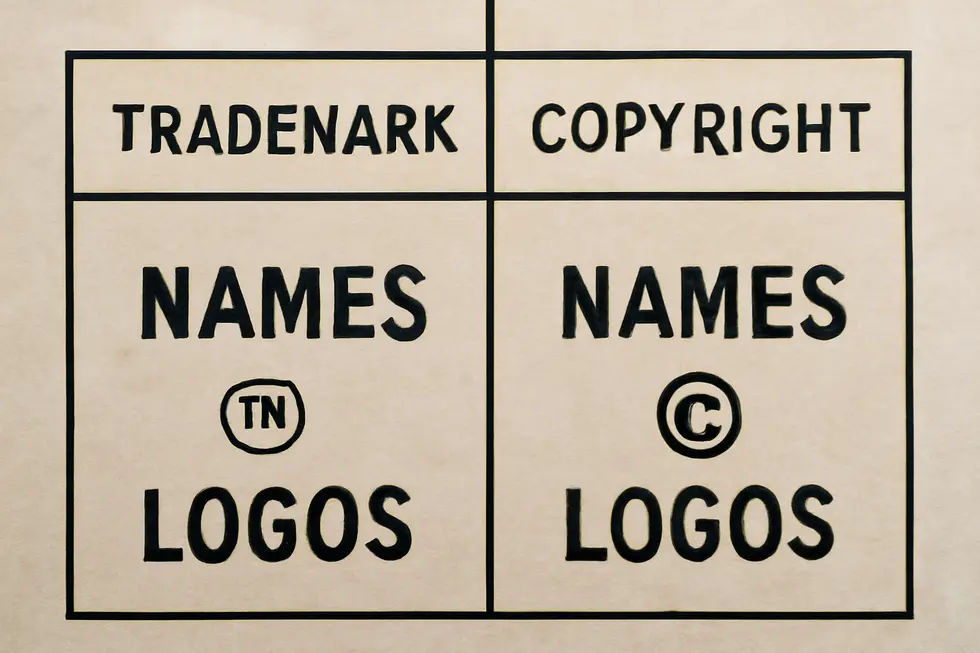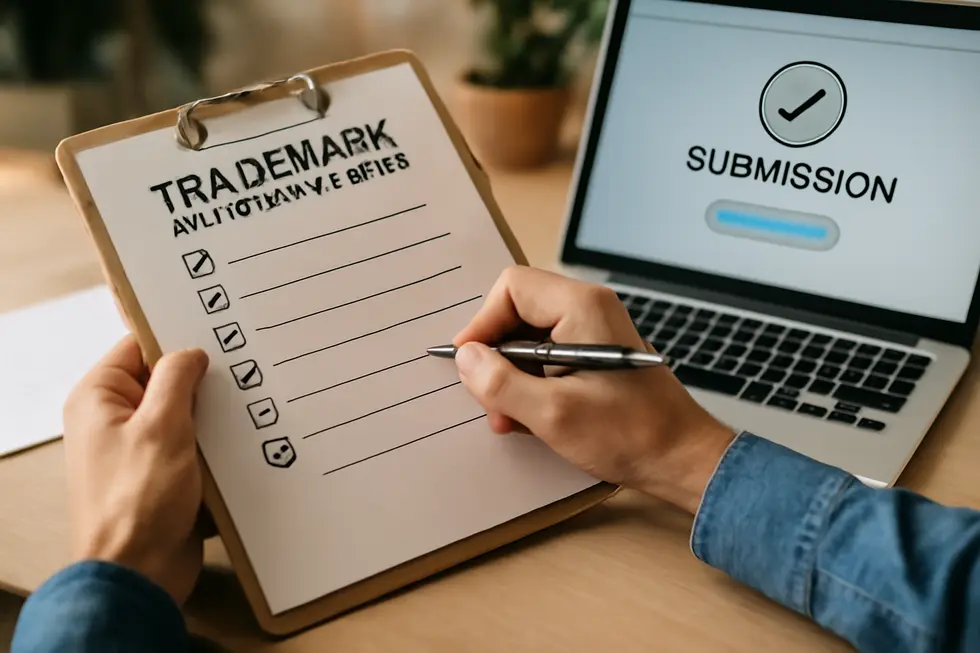Introduction
Securing the identity of your business starts with understanding the legal protections surrounding your brand’s name and logo. Many business owners mistakenly believe that copyright law alone offers comprehensive protection for these vital assets. However, the key safeguard lies within trademark law, which grants exclusive rights for the commercial use of names, logos, and slogans that distinguish your goods or services from competitors. This distinction is critical for maintaining your brand’s integrity and market position. Throughout this guide, you will discover why trademark protection matters, how registration works, the legal rights it confers, and the crucial differences between trademark and copyright protections. Additionally, you’ll learn actionable steps to secure your trademark and avoid potential pitfalls. Each chapter builds a clear understanding of how business owners can effectively protect their brand identity for lasting success.
Tables of Contents
Chapter 1: Trademark Protection for Copyright Business Name and Logo
- Harnessing Digital Innovation: Advanced Technologies in Trademark Enforcement for Business Names and Logos
- The Economic Advantages of Trademarking Your Business Name and Logo
- Navigating Geopolitical Dynamics in Global Trademark Protection
- The Cultural and Ethical Dimensions of Trademark Protection for Business Identity
Chapter 2: The Process of Trademark Registration for Copyright Business Name and Logo
- Navigating Trademark Registration: Essential Steps to Secure Your Business Name and Logo
- Navigating Trademark and Copyright: Understanding Their Roles in Protecting Business Names and Logos
- Balancing Costs and Benefits: Economic Considerations in Trademark Registration and Maintenance
- Navigating Office Actions and Securing Lasting Trademark Protection for Your Business Name and Logo
Chapter 3: Legal Rights Conferred by Trademark for Copyright Business Name and Logo
- Establishing Ownership and Exercising Control Through Trademark Protection
- Navigating Geographic Boundaries and Public Awareness in Trademark Rights for Business Names and Logos
- Clarifying Trademark Versus Copyright Protections for Business Names and Logos
- Maximizing Brand Strength: Strategic Trademark Protection and Commercial Use of Business Names and Logos
Chapter 4: Limitations of Copyright in Protecting Business Names and Logos
- Why Copyright Falls Short: The Technical Boundaries Leaving Business Names and Logos Unprotected
- The Economic Risks of Relying on Copyright for Brand Protection and Why Trademarks Are Essential
- Navigating Geopolitical Boundaries: Trademark Registration Beyond Copyright Limits
- Navigating the Legal Divide: How Trademark Law Fills the Gap Left by Copyright in Brand Protection
Chapter 5: Differences Between Trademark and Copyright in Protecting Business Names and Logos
- Harnessing Digital Technology: How Trademark and Copyright Differ in Online Brand Protection
- The Economic Advantage of Trademark Over Copyright in Valuing Business Names and Logos
- Navigating International Boundaries: Geopolitical Influences on Trademark and Copyright Protection for Business Branding
- How Consumer Trust and Societal Perceptions Shape Trademark Protection for Business Names and Logos
Chapter 6: Practical Steps to Secure Trademark for Copyright Business Name and Logo
- Mastering the Trademark Search: Ensuring a Clear Path for Your Business Name and Logo
- Navigating Trademark Classes: How to Choose the Right Category for Your Business Name and Logo
- Navigating the Trademark Application Journey: Filing, Office Actions, and Maintenance
- Sustaining Your Trademark: Key Strategies to Enforce and Protect Your Business Name and Logo
Chapter 1: Trademark Protection for Copyright Business Name and Logo

1. Harnessing Digital Innovation: Advanced Technologies in Trademark Enforcement for Business Names and Logos
Technological innovations have revolutionized how businesses protect their trademarks, especially regarding business names and logos. Modern AI-driven tools continuously scan the web to identify counterfeit products, phishing attempts, and fraudulent ads, swiftly alerting brand owners to infringements. Meanwhile, digital marketplaces utilize automated blocking systems to prevent unauthorized listings from going live, significantly curbing infringement at the source. Content identification algorithms on platforms popular for video and social sharing expedite takedown of unauthorized use, preserving brand integrity in dynamic environments. Blockchain applications, particularly NFTs, are emerging to establish incontrovertible digital proof of ownership, connecting trademarks to unique digital assets and combatting counterfeit virtual goods. Coupled with strategic registration covering variations of the brand and persistent online surveillance via advanced software, these technologies create a robust defense network. This proactive technological enforcement strengthens legal trademark protections and empowers businesses to maintain exclusive rights in rapidly evolving digital marketplaces. For more insights on protecting brand identity, see company trademarks and logos.
2. The Economic Advantages of Trademarking Your Business Name and Logo
Trademark protection elevates a business name and logo beyond mere identifiers, transforming them into highly valuable intangible assets. By formally registering a trademark, companies secure exclusive rights that help establish strong brand loyalty and consumer trust, signaling consistent quality and authenticity. This legal safeguard enhances marketing effectiveness, allowing businesses to capitalize on brand recognition without fear of infringement. Additionally, trademarks enable the creation of new revenue streams through licensing or sales, turning intellectual property into financial opportunities. They further facilitate smoother market entry and international expansion by reducing risks of consumer confusion and legal challenges. The exclusive commercial rights granted by trademark registration increase the brand’s economic worth, outweighed in the long term by protection against costly disputes. Trademarks also bolster competitive advantage, guiding consumer preferences and attracting investment. Overall, trademark protection is a strategic economic asset that supports sustainable growth and differentiation. For deeper insights into how trademarks impact business value, see this comprehensive guide to trademark protection.
3. Navigating Geopolitical Dynamics in Global Trademark Protection
Trademark protection for business names and logos is inherently shaped by geopolitical realities, as trademarks hold legal weight only within specific national or regional boundaries. This territorial nature means securing rights in one country offers no automatic protection abroad, requiring businesses to register their marks in each significant jurisdiction. Beyond this, legal frameworks vary widely: some countries prioritize “first-to-file” registration, while others, like the U.S., emphasize “first-to-use,” affecting strategies and enforcement. Geopolitical tensions further complicate cross-border trademark enforcement, with differing governmental support, cultural attitudes toward intellectual property, and legal infrastructures influencing how vigorously marks can be defended. To mitigate such risks, companies often craft localized licensing agreements with territorial limits and confidentiality provisions, adapting to each region’s legal environment. These geopolitical factors not only impact legal protection but also shape consumer trust internationally by ensuring brand authenticity is respected across cultures and markets. For strategic insights on licensing trademarks worldwide, refer to best practices outlined in this resource.
4. The Cultural and Ethical Dimensions of Trademark Protection for Business Identity
Trademark protection for business names and logos extends beyond legal safeguards to influence society’s cultural and ethical landscape. By securing exclusive rights to unique identifiers, trademarks help consumers trust and distinguish brands, supporting fair competition and economic stability. However, trademarks also serve as powerful cultural symbols whose meanings resonate within communities, shaping social values and identity. Legal disputes, such as those involving controversial trademarks, raise awareness about cultural sensitivity and social justice, highlighting the need for inclusivity and respect in branding. Moreover, a company’s approach to trademark use reflects its ethical stance, promoting originality and fairness in the marketplace. Respecting others’ trademarks fosters a culture of mutual respect and reduces conflict. Ultimately, trademark protection intertwines with broader societal concerns, influencing not only business but also how communities perceive and value brand identities. For deeper insights, see comprehensive discussions on copyright and trademark brand name and logo protection and social justice intersections in trademark law at PatentPC.
Chapter 2: The Process of Trademark Registration for Copyright Business Name and Logo

1. Navigating Trademark Registration: Essential Steps to Secure Your Business Name and Logo
Registering a trademark for your business name and logo is a structured process that ensures exclusive rights and legal protection. It begins with a comprehensive trademark search to confirm your brand’s uniqueness within your market. Next, you prepare a detailed application including owner information, a precise depiction of the logo or stylized name, a description of associated goods or services, and correct trademark classes. Filing the application follows, typically online through your national Intellectual Property Office or via the Madrid Protocol for international coverage. Once submitted, your application undergoes examination where authorities verify compliance and publish it for public opposition. Prompt responses to any office actions or objections are critical for smooth progression. Upon successful review, your trademark is officially registered, granting exclusive usage rights, but maintaining these rights requires timely renewals and declarations, usually every 5 to 10 years. Leveraging experienced legal guidance can streamline this process and reduce registration risks. For a deeper understanding of trademark protections and distinctions from copyrights, visit copyright brand name & logo protection.
2. Navigating Trademark and Copyright: Understanding Their Roles in Protecting Business Names and Logos
The protection of business names and logos primarily rests with trademark law, which grants exclusive rights to distinctive marks used in commerce. Unlike copyright, which safeguards original creative works, trademark protection focuses on identifiers that distinguish goods or services, such as business names, logos, slogans, or designs. Although an original logo’s artistic elements may receive copyright protection, this does not extend to the business name or guarantee exclusive commercial use. Trademark registration involves verifying uniqueness, conducting searches, submitting an application, and responding to examiner feedback—typically taking 8 to 18 months. This process confers legal rights against confusingly similar uses within the same industry. Meanwhile, registering a business name with local authorities offers no nationwide protection or brand exclusivity. For comprehensive security, businesses should register their business name at the state level and pursue federal trademark registration. Understanding this distinction and interplay helps ensure robust protection of brand identity and legal recourse against infringement. For deeper insights on related copyright and trademark differences, see this detailed guide. More information on the trademark registration process is available from the USPTO and detailed here: https://www.hostinger.com/tutorials/how-to-trademark-a-business-name
3. Balancing Costs and Benefits: Economic Considerations in Trademark Registration and Maintenance
The trademark registration process demands careful economic consideration alongside legal steps. Costs begin with initial trademark searches to confirm a business name or logo’s uniqueness, reducing the risk of costly infringement disputes later. Filing fees vary depending on the number of trademark classes covered, with associated attorney fees often advised to navigate complex legal nuances efficiently. The entire process can span 8 to 18 months, during which examination responses may incur additional expenses and potentially delay market entry.
Beyond registration, maintaining a trademark involves periodic renewal fees to sustain exclusive rights and protect the brand’s identity over time. Though these fees represent ongoing investments, they safeguard a company against rebranding costs that can be far higher if trademarks lapse or are contested. Registered trademarks also bolster a business’s intangible asset portfolio, enhancing market value and attractiveness to investors by demonstrating legal exclusivity.
Separately, registering a business name through state entities is less costly but lacks trademark’s protective strength. For comprehensive protection of brand identity, aligning economic strategy with trademark registration and maintenance is essential. For further details on trademark law fundamentals, see more at trademark law business owners.
4. Navigating Office Actions and Securing Lasting Trademark Protection for Your Business Name and Logo
Successfully registering a trademark for your business name and logo requires more than just filing an application. It begins with a thorough trademark search to confirm your mark’s uniqueness, followed by careful preparation of the application, including correct classification of goods or services. Once submitted, the application undergoes examination by a trademark office examiner who may issue Office Actions if there are conflicts or legal concerns. Responding promptly and strategically to these Office Actions is critical; often, legal expertise is needed to argue distinctiveness or amend the application to address objections. After overcoming these hurdles, your mark enters a publication phase during which third parties can oppose registration. If unchallenged or resolved favorably, you will receive your registration certificate, granting exclusive rights nationwide (in federal systems). Long-term protection demands vigilance—regular renewals, monitoring for infringers, and enforcement actions to preserve your brand’s integrity. Engaging a trademark attorney can streamline this complex process and bolster your chances of successful, enduring trademark protection. For a comprehensive overview of each step, see the detailed trademark registration guide. A full process explanation is also available in this external resource.
Chapter 3: Legal Rights Conferred by Trademark for Copyright Business Name and Logo

1. Establishing Ownership and Exercising Control Through Trademark Protection
A trademark legally establishes ownership and exclusive rights to a business name, logo, or brand identifier linked to specific goods or services. These rights primarily come from registration with governmental agencies like the USPTO or through first commercial use in some jurisdictions. Registration grants a presumption of ownership, public notice of the mark, and enhanced enforcement powers such as federal infringement lawsuits and customs protection against counterfeit goods. Trademark protection ensures that the source indicator—your business name or logo—is exclusively associated with your products or services, preventing confusion in the marketplace. Unlike copyrights, which safeguard creative expression but not brand identifiers, trademarks confer enforceable property rights essential for licensing, brand expansion, and preventing unauthorized use. Joint ownership is permitted when multiple parties use the mark commercially, yet it requires cooperation to manage usage and licensing. This trademark framework fortifies your brand’s identity and supports legal recourse against infringement, making it a critical business asset. Learn more about company trademarks and logos and official guidelines at the USPTO Trademark Basics.
2. Navigating Geographic Boundaries and Public Awareness in Trademark Rights for Business Names and Logos
Trademark rights hinge greatly on geographic reach and the extent of public notice. Common law trademarks arise from actual commercial use and protect business names and logos only within their localized area of recognition—often limited to a city, county, or state. These rights depend on consumer awareness and can extend modestly under doctrines like the natural zone of expansion but remain essentially territorial. In contrast, federally registered trademarks, obtained through the USPTO, grant nationwide protection regardless of where the mark is actively used. This registration also serves as formal public notice, recorded in government databases, which helps prevent infringement by alerting others to prior claims. Common law rights lack this public registry, making enforcement more complex and reliant on proving prior use and recognition. When geographic terms appear in names or logos, their strength as trademarks depends on acquired distinctiveness nationally; otherwise, multiple businesses may legally use such terms if confusion is unlikely. To secure widespread protection and stronger legal standing, combining continuous local use with federal registration is key. For further details on geographic and legal boundaries in trademark protection, see Trademark2Go’s insights on common law trademark rights.
(Reference: Darrow Everett: Registered vs Common Law Trademarks https://trademark2go.com/)
3. Clarifying Trademark Versus Copyright Protections for Business Names and Logos
Understanding the distinct legal protections of trademarks and copyrights is essential for safeguarding your business name and logo. Trademarks protect brand identifiers such as business names, logos (as identifiers of source), and slogans used in commerce to distinguish goods or services. This protection is primarily aimed at preventing consumer confusion and unfair competition, granting exclusive rights within specific industries through federal registration or common law usage. Conversely, copyright protects original creative works, including the artistic design of a logo, immediately upon creation and fixation, without requiring registration. However, it does not extend to business names or grant exclusive commercial use rights for branding purposes. In practice, trademark registration is necessary to prevent others from using similar business names or logos commercially in your market, while copyright protects the unique artistic elements of the logo itself. By leveraging both protections appropriately, businesses ensure their brand’s commercial identity and creative expression remain legally secure. For a deeper explanation, see copyright brand name and logo protection.
4. Maximizing Brand Strength: Strategic Trademark Protection and Commercial Use of Business Names and Logos
Trademark protection is critical for securing exclusive legal rights over business names and logos used to identify goods or services. Unlike copyright, which covers creative works, trademark law focuses on distinctive identifiers that establish brand recognition in commerce. To maximize protection, a business must ensure its name or logo is distinctive and actively used in the marketplace. Registration grants stronger rights and helps combat infringement and dilution, especially for well-known marks that require guardrails against weakening or tarnishing associations. Vigilant monitoring is essential to detect unauthorized uses early, often employing technology to track misappropriation. Trademark owners can commercially exploit their marks through licensing and marketing, securing revenue streams while preventing unauthorized exploitation. However, fair use and parody defenses require careful navigation, as commercial parody risks infringement claims. On a global scale, strategic registration across jurisdictions counters local challenges, such as trademark squatting in certain regions. For practical guidance on protecting business branding via trademarks, explore trusted expert resources like Trademark2Go. Additionally, landmark cases such as Tiffany & Co. v. Costco demonstrate how proactive enforcement preserves brand value over time.[1]
Chapter 4: Limitations of Copyright in Protecting Business Names and Logos

1. Why Copyright Falls Short: The Technical Boundaries Leaving Business Names and Logos Unprotected
Copyright law strictly protects original artistic or literary works, not business names or logos, which are typically short phrases lacking sufficient creativity. Titles, names, and slogans are excluded because they are considered too brief and functional to meet the originality requirement, ensuring common language remains free for public use. The U.S. Copyright Office and courts emphasize that copyright safeguards the author’s unique expression, not ideas or identifiers like business names or logos. This means these elements, essential for branding but simple by nature, cannot be copyrighted. Instead, protection comes from trademark law, which targets preventing confusion by guaranteeing exclusive commercial use of distinctive names and logos. Even with trends like AI-generated content, copyright does not extend to style or short functional marks, reinforcing the legal divide between artistic works and commercial identifiers. For deeper insight into this distinction, see this detailed explanation on copyright exclusions for titles and names.
2. The Economic Risks of Relying on Copyright for Brand Protection and Why Trademarks Are Essential
Copyright law offers protection only to original creative works fixed in a tangible form, excluding business names, short phrases, and simple logos. This leaves trademarks as the critical legal tool for securing commercial brand identity. Without trademark registration, companies risk losing market share and goodwill if competitors imitate their branding, causing consumer confusion and diluting brand value. Economically, trademarks act as valuable intangible assets enhancing business credibility and valuation, especially in expansions and acquisitions. They offer exclusive rights across diverse branding elements—not just names and logos but also unique color schemes and packaging—that copyright cannot protect due to originality thresholds. The robust legal framework trademarks provide enables clearer enforcement and nationwide protection, preventing costly legal battles that copyright law alone cannot sustain. For businesses seeking to safeguard their brand identity effectively, understanding the economic significance of trademarks over copyright is vital. For more insight, see this detailed guide on copyright business name protection.
3. Navigating Geopolitical Boundaries: Trademark Registration Beyond Copyright Limits
Copyright law offers limited protection for business names and logos because its scope focuses on original creative works rather than commercial identifiers. The protection of names and logos is primarily managed under trademark law, which is inherently tied to national jurisdictions. This territorial nature means a trademark is valid only within the country where it is registered, reflecting geopolitical boundaries and legal sovereignty. For businesses targeting international markets, relying solely on national trademarks entails risks, as each country has distinct legal standards, enforcement practices, and cultural attitudes affecting trademark registration and protection. International frameworks like the Madrid Protocol help streamline multi-country registration, yet protection ultimately depends on individual nations’ laws and enforcement. Treaties such as TRIPS harmonize some trademark rules across borders but cannot fully replace the necessity for multiple registrations. As a result, companies must strategically balance national and international trademark registrations to secure their brand identities beyond the limited reach of copyright. For a deeper understanding, explore trademark registration essentials and its role in brand protection at trademark registration for business owners. More details on the Madrid system and territorial trademark rights can be found at the World Intellectual Property Organization (WIPO) official site.
4. Navigating the Legal Divide: How Trademark Law Fills the Gap Left by Copyright in Brand Protection
Copyright law excludes business names, logos, and short phrases because they lack the originality and creative authorship needed for protection. This exclusion preserves the free use of language essential for commerce and communication. Instead, trademark law bridges this gap by granting exclusive rights to distinctive names, logos, and slogans in connection with goods or services. This legal framework balances societal interests by ensuring businesses can protect their brand identities while allowing common language to remain accessible. However, trademark protection demands active registration and enforcement, which can be complex and costly. It focuses on preventing consumer confusion rather than safeguarding creative expression, leaving generic or descriptive terms hard to protect unless they acquire secondary meaning. These dynamics encourage businesses to invest in unique branding but also introduce potential legal disputes over similar marks. Thus, understanding this legal landscape is crucial for effective brand defense. For more insight, explore trademark registration and enforcement guidance.
Chapter 5: Differences Between Trademark and Copyright in Protecting Business Names and Logos

1. Harnessing Digital Technology: How Trademark and Copyright Differ in Online Brand Protection
In the digital age, protecting a business name and logo involves distinct technological approaches under trademark and copyright laws. Trademarks specifically guard the identifiers of commerce—names, logos, slogans—ensuring a brand’s exclusive presence across websites, social media, and e-commerce channels. Advanced AI-powered monitoring tools actively scan images and content on platforms like Instagram and Amazon, enabling rapid identification of unauthorized use. Trademarks also evolve to include non-traditional marks such as motion or sound logos prevalent in apps and videos, demanding clear distinctiveness for legal recognition. Meanwhile, copyright safeguards original creative expressions inherent in logos or artwork, automatically attaching upon creation. Digital copyright enforcement focuses on tracking unauthorized copying or distribution via dedicated online monitoring systems. However, copyright protection does not extend to preventing similar commercial use of a brand identifier. Effectively securing an online brand requires a complementary strategy: leveraging trademark registrations paired with cutting-edge digital enforcement for brand identity, alongside copyright for artistic elements. This dual approach addresses the unique challenges of online brand security, from platform-specific misuse to the fast-paced nature of digital content circulation. For detailed insight on legal grounding and enforcement dynamics, see trademark and copyright law for business owners.
2. The Economic Advantage of Trademark Over Copyright in Valuing Business Names and Logos
Trademark protection plays a pivotal role in enhancing the economic value of a business by securing its name and logo as unique identifiers that foster customer loyalty and market trust. Unlike copyright, which safeguards only the artistic elements of a logo without preventing marketplace confusion, trademarks ensure exclusive commercial use, directly contributing to stronger brand recognition and goodwill. This exclusivity bolsters a company’s intangible assets, often increasing its market valuation and appeal in mergers, acquisitions, and investor negotiations. Registered trademarks provide nationwide legal enforcement, making it easier to combat infringement and counterfeit goods—a critical factor in maintaining brand integrity and long-term growth potential. Though copyright complements trademark by protecting creative originality, it does not inherently safeguard the economic interests tied to brand identity. Thus, businesses benefit most economically from prioritizing trademark registration while using copyright as an ancillary safeguard. For more on the distinctions in IP protection strategies, see common law trademark rights.
External reference: https://www.uspto.gov/trademarks/basics
3. Navigating International Boundaries: Geopolitical Influences on Trademark and Copyright Protection for Business Branding
Protecting business names and logos internationally demands a nuanced understanding of geopolitical influences shaping trademark and copyright law. Trademarks grant exclusive rights tied to territorial registration systems, which differ widely—some countries prioritize first-to-file, others first-to-use. Enforcement depends on local rules, and international treaties like the Madrid Protocol streamline multi-country registration but do not establish a global trademark. Copyright shields the creative expression behind logos but not the business identifiers themselves. While protection is automatic under the Berne Convention, enforcement varies by jurisdiction and cultural context. Licensing agreements are shaped by local legal and economic conditions, complicating cross-border enforcement. Cultural attitudes also influence how rigorously intellectual property laws are applied, impacting business strategies. Understanding these geopolitical and legal distinctions is essential to secure and enforce intellectual property rights internationally. For further insights on managing trademark licensing in global markets, explore resources like Trademark2Go. More on international trademark registration and enforcement can be found through the Madrid Protocol guidelines.
4. How Consumer Trust and Societal Perceptions Shape Trademark Protection for Business Names and Logos
Trademark protection hinges on society’s role in shaping consumer trust and brand recognition. Unlike copyright, which safeguards creative works, trademarks directly protect identifiers like business names and logos that signal product origin. This exclusivity prevents marketplace confusion and builds confidence in a brand’s quality and reliability. Society relies on trademarks as visible marks of authenticity, often strengthened by federal registration that enhances legal enforcement and consumer assurance. Without trademark protection, similar branding can dilute trust and create uncertainty among consumers, weakening a company’s reputation and economic standing. Moreover, public understanding often conflates business name registration with full brand protection, overlooking the layered legal distinctions between a business’s entity name and its trademarked brand identity. These societal perceptions influence how businesses approach intellectual property protection, recognizing trademarks as essential tools to foster lasting consumer trust and maintain competitive advantage. For deeper insights, explore trademark protection and business name nuances and external analysis from Trademark2Go’s economic and societal impact overview.
Chapter 6: Practical Steps to Secure Trademark for Copyright Business Name and Logo

1. Mastering the Trademark Search: Ensuring a Clear Path for Your Business Name and Logo
Securing a trademark begins with a comprehensive search to avoid conflicts that could block registration and cause future disputes. Start by identifying the proper trademark classes for your goods or services, since trademarks are registered by specific categories. Carefully search exact spellings and variants of your business name, including phonetic equivalents, because official databases often require precise matches. For logos, leverage the Trademark Design Search Manual to find design codes reflecting your logo’s elements, then scan those codes for similar registered designs. Modern AI-powered search tools enhance this process by analyzing text, phonetics, and visuals simultaneously, uncovering potential conflicts across jurisdictions. Don’t overlook searching beyond federal databases—explore state trademarks, business registries, domain names, and informal sources like social media to track common law usage. Monitoring the USPTO’s Trademark Official Gazette reveals recently published marks pending opposition, providing timely intelligence. Engage a trademark attorney to interpret search findings, advise on eligibility, and assist in application preparation and prosecution. This layered approach creates a thorough foundation for trademark registration, safeguarding your brand identity effectively and minimizing risks. For more details on trademark clearing searches, consult the University of Washington’s trademark search guide.
2. Navigating Trademark Classes: How to Choose the Right Category for Your Business Name and Logo
Securing a trademark requires carefully selecting the right class that corresponds to your business activities. Trademark law organizes protection through the internationally recognized Nice Classification system, which divides goods and services into 45 distinct classes. Begin by precisely identifying the products or services your business offers, as this forms the basis for selecting an appropriate class. For instance, apparel falls under Class 25, while marketing and advertising services are categorized in Class 35. Conducting a thorough search of existing trademarks within your jurisdiction’s database helps avoid conflicts with similar marks already registered. If your business spans multiple offerings, you may register under multiple classes—each incurring separate fees. It’s crucial to describe your goods and services with enough precision to delineate your scope, yet broad enough to accommodate future growth. Your trademark application must include exact representations of your business name, logo, or slogan, ensuring clarity in protection scope. Properly navigating trademark classes strengthens your brand’s legal foundation and supports sustainable expansion. For detailed classifications, consult the official Nice Classification system or resources like trademark2go.com.
3. Navigating the Trademark Application Journey: Filing, Office Actions, and Maintenance
Securing a trademark for your business name and logo begins with a comprehensive trademark search to avoid conflicts. Once clear, the application must be carefully prepared including correct classification of goods or services, detailed descriptions, and proof of use or intent. Filing is typically done electronically through official portals, streamlining submission and fee payment. After submission, the trademark office reviews the application, potentially issuing Office Actions to raise concerns such as similarity to existing marks or insufficient documentation. Prompt and precise responses to these communications are essential to prevent delays or abandonment. Upon approval, the trademark enters publication for opposition, with final registration contingent on no challenges. For intent-to-use filings, submitting a Statement of Use demonstrates active commercial use before registration is granted. Post-registration, maintaining protection requires filing periodic maintenance documents within specified timeframes to keep the trademark active. Attention to detail during each phase—from selecting the right classes to timely responses—maximizes your brand’s legal security. For further guidance, review the detailed filing procedures on the USPTO website. This methodical process ensures robust legal protection distinct from copyright safeguards and is crucial for defending your business identity. For more insights on trademark law and business name protection, explore this copyright brand name and logo protection resource.
4. Sustaining Your Trademark: Key Strategies to Enforce and Protect Your Business Name and Logo
Securing a trademark is just the beginning of protecting your business name and logo. Maintaining these rights requires proactive vigilance and consistent upkeep. Regularly monitor the market to detect unauthorized or confusingly similar uses that may dilute your brand’s distinctiveness. Promptly addressing infringements through cease-and-desist letters or legal action reinforces your rights and deters future violations. Equally important is the timely renewal of your registration, as trademark protection hinges on maintaining active status under jurisdictional rules. Consistent, deliberate use of your trademark not only strengthens public recognition but also enhances its enforceability in disputes. This ongoing dedication safeguards your brand’s value and legal standing amidst a competitive landscape. For comprehensive guidance on enforcing your trademark rights and the nuances of protection, explore detailed resources available at trademark2go.com/company-trademarks-logos. Additionally, for official procedural details including renewal requirements, consult the USPTO Trademark Center.
Final thoughts
Protecting your business name and logo is pivotal to establishing and maintaining a strong market presence. While copyright law offers some safeguards for creative works, it does not provide the exclusive, industry-specific protections necessary for branding elements. Trademark law fills this gap by awarding distinctive legal rights that prevent competitors from using confusingly similar marks in commerce. Understanding the nuances between these protections, knowing the registration process, and taking proactive steps to register your trademark empowers you to safeguard your brand effectively. As your business grows, these protections become assets that support your reputation, customer trust, and overall business value. Investing in trademark protection today fortifies your brand’s future and shields your identity from infringement.
Your IP is the foundation of your success – let’s protect it together before it’s too late. We can’t wait to help you turn your ideas into legally secured assets.
About us
undefined


